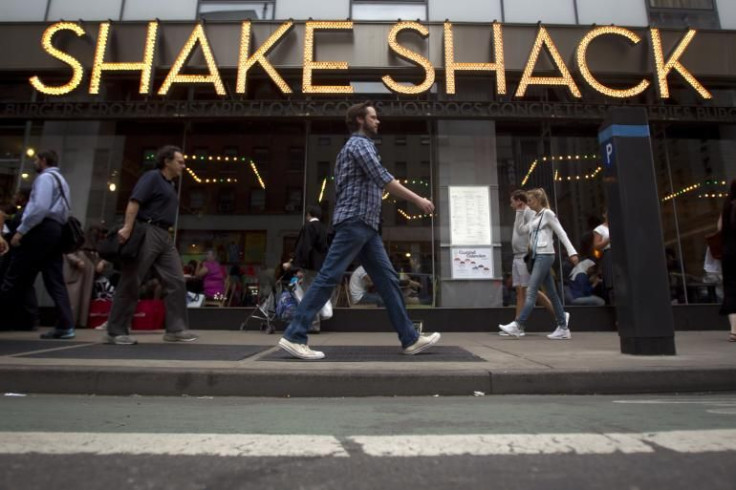Shake Shack Inc (SHAK) Stock Price Soars 130% In IPO Debut

Shares of fast-casual burger chain Shake Shack Inc. (NYSE:SHAK) soared more than 130 percent Friday, opening at $47 per share, after the company began trading on the New York Stock Exchange. The burger joint’s shares opened well above its IPO price of $21, valuing the company at more than $1 billion.
UPDATED: 4 p.m. EST
Shake Shack shares rose 118.24 percent Friday to close at $45.83 on th NYSE. The stock rose as high as $52.50 in intraday trading.
Restaurateur Danny Meyer opened the company's first location in New York’s Madison Square Park in 2004. As part of the IPO, Shake Shack, which is owned by the Union Square Hospitality Group, will spin off into a separate company.
The burger joint announced Thursday evening it raised $105 million in its IPO and was offering 5 million shares at $21, topping Wall Street expectations and initially valuing the company at more than $700 million. Shake Shack had previously increased its IPO range Wednesday to $17 to $19 per share, up from $14 to $16 a week ago.
JPMorgan, Morgan Stanley, Goldman Sachs and Barclays are among the major underwriters for the IPO, according to Shake Shack's preliminary S1 documents. Last year was the largest for the U.S. IPO market since 2000. Between Jan. 1 and Dec. 16, 2014, there were 288 U.S. initial public offerings, which raised a total of more than $94 billion in 2014, according to Dealogic.
How Shake Shack Compares With Chipotle, El Pollo Loco And Dave & Buster's
Ahead of the company's IPO, Rapid Ratings International rated Shake Shack an 85, or “very low risk,” on its 0 to 100 scale that measures a company’s financial health. The rating indicates the company is an exceedingly healthy business, an outlier among its peers.
“When you look at some of the more recent names to have gone public, such as Potbelly's, El Pollo Loco and Dave & Buster's, Shake Shack is definitely much stronger than those,” James Gellert, chairman and chief executive officer at Rapid Ratings International, said.
So-called fast-casual food chains have been popular with investors in recent years. But one of the questions that keeps popping up to the forefront for investors is how Shake Shack will maintain its current margins and profitability once it expands.
“That is really the question that investors need to be focused on over the next handful of quarters as Shake Shack moves beyond the more than 60 locations they now have and how the company uses those proceeds wisely,” Gellert said. “But when you look at how strong Shake Shack is currently, they separate from most of their peers, and it puts them up near Chipotle, which we consider to be very strong company.”
Shack-onomics
Shack sales, which represent combined sales of food and beverages in domestic company-operated Shacks, generated $79 million for the first nine months of 2014, excluding licensing revenue. That compares with $56.8 million during the same period a year earlier, an increase of 39 percent. The growth was driven primarily by the debut of 10 domestic stores from September 2013 to September 2014.
Shake Shack’s opportunities seem vast. The restaurant industry’s burger market, the largest dine-out segment in the U.S., generated more than $72 billion in sales in 2013, according to Technomic. The burger industry is about twice the size of the pizza market, which is the next largest U.S. category. Burgers are also the most portable concept internationally, with an estimated global market size of more than $135 billion.
Shake Shack's Plans for the Future
Shake Shack, which filed for an IPO on Dec. 29 with the U.S. Securities and Exchange Commission, plans to use a portion of the IPO proceeds to expand its footprint to at least 450 stores by opening eateries in new and existing markets both in the U.S. and abroad, according to the SEC filing. Shake Shack aims to fill in existing markets such as New York, Boston, Philadelphia, Washington, Atlanta, Chicago and South Florida and also enter new markets such as Austin, Texas.
There are currently 63 Shake Shacks worldwide in nine countries and 34 cities, including Dubai, Istanbul, London and Kuwait. There are 31 U.S. company-operated Shacks, seven in Manhattan and 24 elsewhere. The Middle East has been the company’s most prominent growth market, with 20 Shacks in operation, followed by four in Turkey, two in Russia and one in the U.K.
The company opened 10 U.S. stores in 2014 and plans to open at least 10 new domestic stores each year beginning in fiscal 2015 for the "foreseeable future," according to Shake Shack's preliminary S1 documents.
© Copyright IBTimes 2024. All rights reserved.












